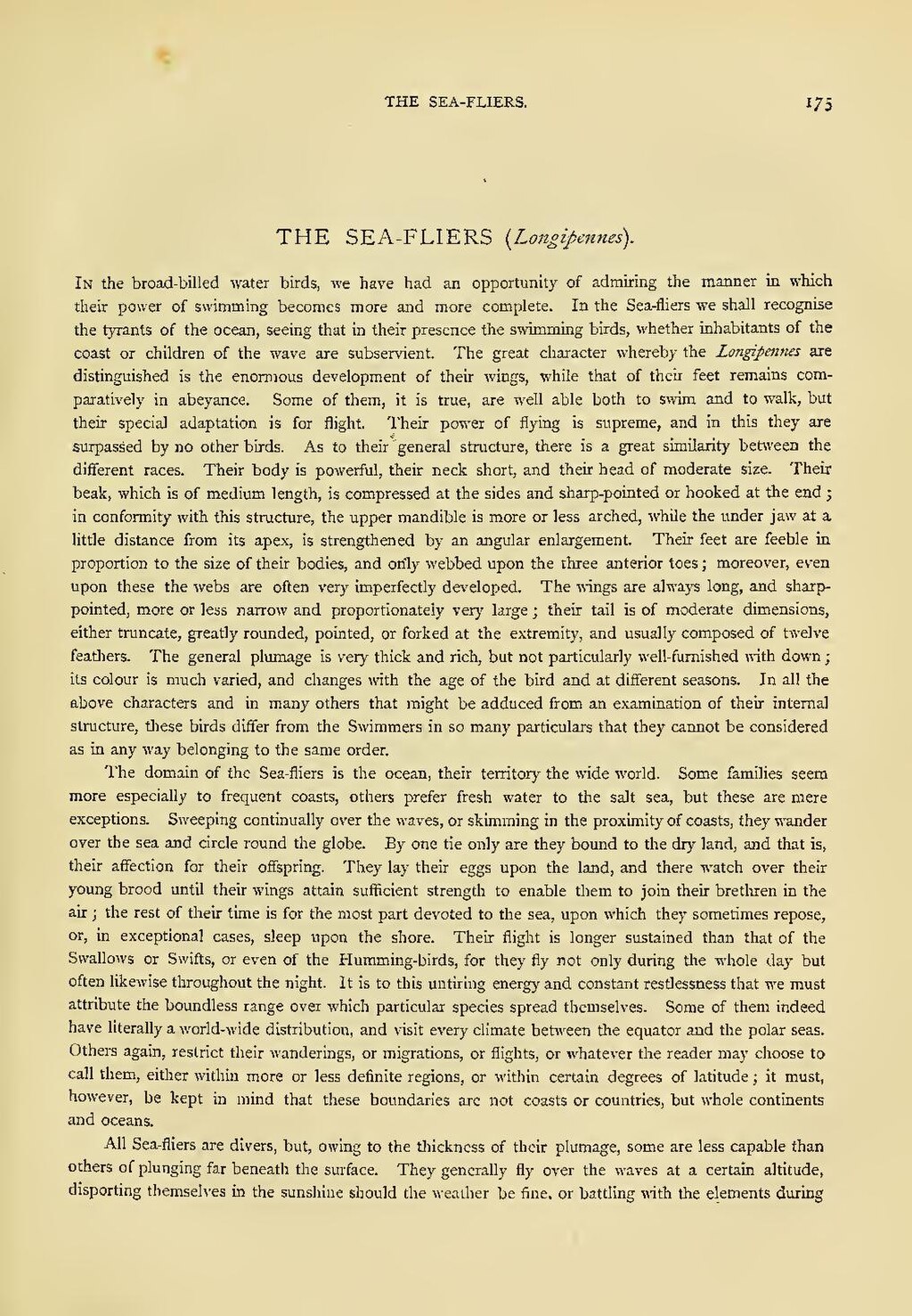In the broad-billed water birds, we have had an opportunity of admiring the manner in which their power of swimming becomes more and more complete. In the Sea-fliers we shall recognise the tyrants of the ocean, seeing that in their presence the swimming birds, whether inhabitants of the coast or children of the wave are subservient. The great character whereby the Longipennes are distinguished is the enormous development of their wings, while that of their feet remains comparatively in abeyance. Some of them, it is true, are well able both to swim and to walk, but their special adaptation is for flight. Their power of flying is supreme, and in this they are surpassed by no other birds. As to their general structure, there is a great similarity between the different races. Their body is powerful, their neck short, and their head of moderate size. Their beak, which is of medium length, is compressed at the sides and sharp-pointed or hooked at the end; in conformity with this structure, the upper mandible is more or less arched, while the under jaw at a little distance from its apex, is strengthened by an angular enlargement. Their feet are feeble in proportion to the size of their bodies, and only webbed upon the three anterior toes; moreover, even upon these the webs are often very imperfectly developed. The wings are always long, and sharp-pointed, more or less narrow and proportionately very large; their tail is of moderate dimensions, either truncate, greatly rounded, pointed, or forked at the extremity, and usually composed of twelve feathers. The general plumage is very thick and rich, but not particularly well-furnished with down; its colour is much varied, and changes with the age of the bird and at different seasons. In all the above characters and in many others that might be adduced from an examination of their internal structure, these birds differ from the Swimmers in so many particulars that they cannot be considered as in any way belonging to the same order.
The domain of the Sea-fliers is the ocean, their territory the wide world. Some families seem more especially to frequent coasts, others prefer fresh water to the salt sea, but these are mere exceptions. Sweeping continually over the waves, or skimming in the proximity of coasts, they wander over the sea and circle round the globe. By one tie only are they bound to the dry land, and that is, their affection for their offspring. They lay their eggs upon the land, and there watch over their young brood until their wings attain sufficient strength to enable them to join their brethren in the air; the rest of their time is for the most part devoted to the sea, upon which they sometimes repose, or, in exceptional cases, sleep upon the shore. Their flight is longer sustained than that of the Swallows or Swifts, or even of the Humming-birds, for they fly not only during the whole day but often likewise throughout the night. It is to this untiring energy and constant restlessness that we must attribute the boundless range over which particular species spread themselves. Some of them indeed have literally a world-wide distribution, and visit every climate between the equator and the polar seas. Others again, restrict their wanderings, or migrations, or flights, or whatever the reader may choose to call them, either within more or less definite regions, or within certain degrees of latitude; it must, however, be kept in mind that these boundaries are not coasts or countries, but whole continents and oceans.
All Sea-fliers are divers, but, owing to the thickness of their plumage, some are less capable than others of plunging far beneath the surface. They generally fly over the waves at a certain altitude, disporting themselves in the sunshine should the weather be fine, or battling with the elements during
